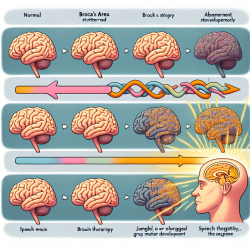Introduction
Stuttering is a complex developmental communication disorder that affects approximately 1% of the population. Despite advances in understanding the genetic and neural influences on stuttering, the etiology and pathophysiology remain poorly defined. Recent research has begun to shed light on the neuroanatomical abnormalities associated with stuttering, particularly in Broca's area, a region critical for speech production.
Research Findings
The study titled "The trajectory of gray matter development in Broca’s area is abnormal in people who stutter" explores the differences in cortical thickness in the left pars opercularis of Broca's area between individuals who stutter and those who do not. The research involved structural magnetic resonance imaging (MRI) of 116 males, including 55 individuals who stutter, ranging in age from 6 to 48 years.
Results indicated that, unlike their peers, individuals who stutter do not exhibit the typical maturational pattern of gradual gray matter thinning with age in the left pars opercularis. This finding suggests a deviation in the developmental trajectory of this brain region, which is crucial for speech-motor control.
Implications for Practitioners
Understanding these neurodevelopmental differences is essential for speech-language pathologists and other practitioners working with individuals who stutter. The insights gained from this research can inform therapeutic approaches and highlight the importance of early intervention.
- Early Identification: Recognizing stuttering early in children can allow for timely intervention, potentially mitigating the impact of abnormal gray matter development.
- Targeted Therapy: Therapies that focus on enhancing speech-motor control could be beneficial, considering the role of Broca's area in speech production.
- Continued Research: Encouraging further research into the neurodevelopmental aspects of stuttering can lead to more effective treatment strategies.
Encouraging Further Research
While this study provides valuable insights, it also underscores the need for continued research into the neurodevelopmental aspects of stuttering. Future studies could explore the potential for neuroplasticity and the effectiveness of various therapeutic interventions in altering the developmental trajectory of gray matter in Broca's area.
Conclusion
The findings from this study offer a deeper understanding of the neuroanatomical underpinnings of stuttering and highlight the importance of targeted therapeutic interventions. By leveraging these insights, practitioners can enhance their approaches to treating individuals who stutter, ultimately improving outcomes.
To read the original research paper, please follow this link: The trajectory of gray matter development in Broca’s area is abnormal in people who stutter.










